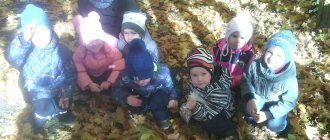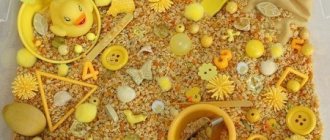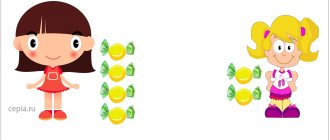Abstract of GCD in the senior group “What do we know about water, they say it’s everywhere”
Description of material:
I bring to your attention a summary of the educational activity on familiarization with the outside world with elements of experimentation for children of the older group on the topic: “What do we know about water, they say it is everywhere.” This material will be useful to teachers of the senior group. This is a summary of an educational and research lesson aimed at expanding children's knowledge about water and developing curiosity in preschoolers.
Integration of educational areas:
“Cognition”, “Communication”, “Socialization”, “Cognitive-research”, “Reading fiction”, “Productive”.
Target:
generalize children's knowledge about water.
Tasks:
Educational:
Expand children's understanding of the properties of water, the importance of water in the life of animals, plants and humans, and its role in nature. Teach children to conduct simple experiments with water. To give children an understanding of why water sometimes needs purification and to give a basic understanding of the filtration process.
Educational:
Develop thinking, attention, memory, ability to analyze and observe. Develop skills in conducting laboratory experiments and curiosity.
Speech:
Develop coherent speech, enrich children's vocabulary: evaporation, filters, filtration, wastewater treatment plants, the water cycle in nature.
Educational:
To instill in children a careful attitude towards water, to develop skills in everyday environmental behavior in relation to water supplies.
Demo material:
illustrations depicting the planet’s water resources (rivers, lakes, seas, oceans); demonstration poster “Water cycle in nature”; box “with a riddle (piece of ice)”; a pre-cut balsam sprig in a glass of colored water; distribution with objects - an apple, a small fresh fish, a sprig of balsam, a slice of watermelon; bucket of water.
Handout:
for experimental work - mirrors, pieces of cotton wool and gauze, funnels, plastic glasses, two per child, water from the river, aprons and hats, for games - paper masks for children with drawings of droplets, one mask with the image of the Sun, and one with the image -Clouds.
Methodical techniques:
Organizational moment, game situation, conversation-dialogue, examination of illustrations, conversation, experimentation, creation of a problem situation, physical education minute-didactic game, analysis, summing up.
GCD move:
Children are included in the group. Educator:
- Good morning, I tell you, Good morning!
I love you all! I wish you to study well. Listen carefully, gain your mind. — Guys, I have prepared interesting riddles for you. Here's the first riddle. Go to the table (the children find a box on the table with a round hole on the side). - Touch with one hand what lies inside the box, but do not tell the answer, keep it secret (“in your fist”). - Here is the second riddle - a sound one (the sound of the sea surf, the splash of waves). - Now tell me: what was in the box and what sounds did you hear? What will we talk about in today's lesson? (children's answers). - Yes, that’s right, there was a piece of ice in the box, which in your palms quickly turned into water and the sounds of the sea surf are also familiar to you. Today's lesson will focus on water. Educator:
Have you heard about water? They say she is everywhere! In a puddle, in the sea, in the ocean And in a water tap Like an icicle freezes, It creeps into the forest with fog It’s boiling on our stove, The steam of the kettle hisses. Without it, we can’t wash ourselves, we can’t eat, we can’t get drunk! I dare to report to you, We cannot live without water. (N. Ryzhova)
- What do you guys think, why can’t all living things survive without water? (children's answers). - That's right, they also say about water - water - resin, that is, water is life. Now go to the table and let's see what's on it (on the table there is an apple, fresh fish, a sprig of balsam and a picture of a watermelon). Educator:
- Today we are talking about water, and what does what is in front of you have to do with water (full answers from children).
- I agree with you, watermelon contains a lot of juice, that is, water, an apple also contains juice. Water is the habitat of fish. If we crush the cut stem of a balsam sprig with our fingers, we will feel the moisture. And the leaves also contain water. Where? Why? - Yes, that’s right, we water the flowers with water, the plant’s roots absorb the water and it flows through the stem into the leaves. And balsam is popularly called “Vanka-wet”, since before the rain numerous drops of water appear along the edges of the leaves. To confirm this, consider the experiment we conducted earlier. A sprig of balsam was placed in a jar of red-colored water. -What did you notice? (children's answers). The stem and leaves turned yellow. This proves that the plant needs water, the plant “drinks” the water and it travels along the stem to the leaves. Educator:
- Now I ask you to close your eyes and see what has changed?
(exchanges fresh fish for dry). - You correctly noticed that the fish became dry, there was no water in it. Where did the water go? (children's answers). - That's right, the water evaporated, that is, turned into steam. - Give examples when you observed the evaporation of water? (Mom hangs the laundry out on the balcony after washing and it becomes dry, wipes the table with a wet rag, washes the floors). - And now I suggest you play an interesting game “Droplets Are Walking in a Circle.”
But for this you need to turn into small droplets (music reminiscent of rain sounds, the teacher asks the children to put on droplet masks, she puts on the cloud mask and the game begins).
Educator: I am Tuchka’s mother, and you guys are my droplet children, and it’s time for you to hit the road. (Music.) The droplets jump, run, and dance. Droplets flew to the ground. Let's jump and play. They got bored jumping around alone. They gathered together and flowed in small cheerful streams. (The droplets form a stream, holding hands.) The streams met and became a big river. (The streams are connected into one chain.) Droplets float in a large river and travel. The river flowed and flowed and ended up in the ocean (children form a round dance and move in a circle). The Droplets swam and swam in the ocean, and then they remembered that Mother Cloud told them to return home. And then the sun just warmed up. The droplets became light and stretched upward (crouched droplets rise and stretch their arms upward). They evaporated under the rays of the sun and returned to my mother, Tuchka. Well done, droplets, they behaved well, they didn’t get into passers-by’s collars or splash themselves. Now stay with me, I miss you. - Now we will draw a conclusion: the sun heats the earth, water, when it heats up, rises, there it cools and falls in the form of rain, snow, back to the earth, into rivers, seas, oceans. This phenomenon in nature is called the water cycle in nature. Let's all repeat it in unison (we look at the poster “The Water Cycle in Nature”). Water evaporates from the surface of the earth under the influence of the sun, forms clouds, and returns to the earth in the form of rain and snow. The water cycle in nature occurs every day, at any time of the day, in any weather, at any time of the year. — Let's continue talking about water. We are talking about the fact that all living things need water and are made of water. - Tell me, is there liquid in a person? What proves that we have water in us? (children's answers). - Yes, I completely agree with you, these are tears, drool, sweat, blood. And to make sure of this once again, we will go to the girls’ play corner and use the small mirrors from the box. Educator:
- Take the mirrors in your hands, breathe on them with your mouth slightly open and immediately touch the mirror. What do you feel? (children's answers). - Yes, my finger became wet. This experience proves that a person has water in him and when he breathes, he loses it. Let's go to the laboratory again (put on aprons and caps). — Before we start work, here’s another question: where do we get water? (children’s answers). - How does she get into our house? (through pipes, from the river). - Guys, have you seen what kind of water flows in the river? (cloudy, dirty, dark). — What kind of water flows from the tap? (clean, transparent). - What kind of transformation happens to water? (it is cleaned). — To get into the tap, water is purified by many machines and devices. Every major city has treatment facilities in which incoming water from the river undergoes special treatment, after which clean water is supplied through pipes to residents’ homes. And many of you have filters for water purification at home (look at the illustrations). Thus, you and I drink clean water. - So, in front of you in glasses is water from our Volga River. Through the walls of the glasses you can see that the water from the river is dirty. And we will try to purify the water in our laboratory. The first thing we'll do is make filters. To do this, take a piece of cotton wool and a piece of gauze, folded in four layers. Place cotton wool and gauze in a funnel. Place the funnel in a clean glass. We will pour dirty water from the river in a thin stream into a funnel with a filter. — Can you see through the transparent walls of the glass that the water has become cleaner? But you can’t drink this kind of water yet. And to achieve even better results when purifying water, you can add, for example, coal to a glass of purified water. Leave for a while and filter the water again. Such water will be considered well purified. But how much time we spent purifying just a few glasses of water. And adults, those who work at wastewater treatment plants, have to spend a lot of effort, money and time to obtain clean water. Therefore, water must be conserved and treated with care.
A river flows from afar, A river flows from afar, How beautiful and deep, Or maybe it’s the ocean? Preschooler Ivan Sidorov forgot to turn off the tap in the kitchen.
— Guys, today we brought a bucket of water with us to class. This is water that dripped overnight from a slightly open tap. Where do we put this water? (water the flowers, wash the toys, wash the doll’s clothes). That’s right, we will treat water with care. And so that you always remember this, we will hang this sign (a crossed out faucet with a drop of water) in the washroom. — Let’s invite our guests to listen to tips on how to save water (children’s answers: don’t waste water; close the tap tightly; don’t play with water that flows from the tap; don’t leave taps open unnecessarily). Well done guys, your advice is very important. - And now I invite you to remember everything that you learned about water in today’s lesson (the children, together with the teacher, recall bright and interesting moments, answer questions, sum up the lesson).
Author: Kazantseva Tatyana Aleksandrovna
teacher, MDOU Novoulyanovsky general development kindergarten “ABVGDeyka” Novoulyanovsk, Russia The article is published in the author’s edition
MAGAZINE Preschooler.RF
Pavlova Luiza Nikolaevna teacher MBDOU Yanshihovo-Norvashi kindergarten Chuvash Republic, Yantikovsky district, Yanshikhovo-Norvashi villageTopic: “Water Sorceress” (experiments with water for older children) Purpose: - Develop interest in natural and weather conditions. To introduce and show the form in which water exists in nature, with the various phenomena of rain, dew, snow, frost, steam, ice and the state of water in the environment; To introduce the different properties of water. Excursion to nature in the summer. "Where is the water?" (in a pond, on a stream and spring, in a well). -Where do we get water from at home and in kindergarten? (children's answers) Conversation about water. Experiment No. 1. Taste of water.
Goal: Is there potable water everywhere? (No) -What does water taste like? Spring water sample. A sample of water taken from the tap in the group. Well water sample. Comparison of the taste of water. CONCLUSION: spring water is the healthiest, the purest, it comes from the depths of the earth. Where else does water exist?
Experiment No. 2. "Warm water"
Objective: Find out by comparing water from different places. Which place has the warmest water? Conclusion: Spring water and well water are the coldest. The warmest water is from the river, because it warms up in the sun. Experiment No. 3. “Dew” Purpose: Where did the dew come from? While exercising on the site, our feet got wet and we learned that dew falls in the morning. We noticed dew on the grass flower beds. It appears to fall out when wet and is able to moisturize nature. Experiment No. 3 Water in vegetables and fruits"
A teacher and children squeeze the juice of tomatoes and tangerines. All children see juice flowing out of them. Conclusion: there is water (in vegetables, fruits). -Why do people need water? (children's answers). Water has a wonderful property; it can dissolve various substances. Once you eat a pie, the water dissolves the pie into small particles and the blood distributes the nutrients throughout the body, to every cell. Water is a real magician. She knows how to transform and change. Experiment No. 4 “Colorless water” Take a glass of water and add salt to it, see what happened? (salt has dissolved). Did the salt change the color of the water? ( No). We taste the water - it is salty. Conclusion: When salt is added, water can remain the same clear, but the taste will change. Experiment No. 4 “Where did the water disappear? “We pour river water into a bottle, close the lid, put it in the sun and leave it for a month, hiding it from strangers. After a month we come back and find out how it decreased. After all, we left a full bottle, but here it is incomplete. Conclusion: Water evaporates in the sun.
Experiment No. 5. "Cold water"
Purpose: Why is the water cold? In late autumn we return to the river. For some reason the water in it became cold. Conclusion: We find out that the state of water in nature changes due to cooling weather conditions.
Experiment No. 6. “Icy water” Goal: “Where did the piece of ice come from?” We return to the river in the cold autumn, when the ground around us is frozen and we see that the river is covered with a thin piece of ice on top. We take a piece of ice from the river and determine what it is? It turns out that the water froze in the river and turned into ice. A piece of ice is like glass and can break very quickly. Conclusion: Water can change its previous shape.
Experiment No. 7. "Ice rink"
Goal: With the onset of winter, we come to the hill with a sled. The former river and the ground are covered with snow. We check, will the ice support us if we step on it? The children and I clean the snow on the ice and check that the ice has become strong. There is nothing to be afraid of, he will withstand us. It is smooth, slippery, you can even slide on ice. Game "Sliding on Ice"
Conclusion: The ice is compacted, it is smooth, cold, hard and slippery.
Experiment No. 8. “Patterns on the window” Purpose: How are patterns on windows created? We spent a long time wondering with preschoolers how patterns appear on windows? They began to observe and found out: steam rises from the kitchen, collides with warm air coming out of the window and, as a result, the steam sticks to the window and from this patterns are created on the windows. Conclusion: The meeting of warm air with cold air can create patterns on windows. Experiment No. 9. “Trees in frost” Purpose: “Where does frost come from?” On a walk with preschoolers, we noticed how the trees were covered with frost. After all, before there was no thin layer of snow cover attached to the tree branches. To clarify this phenomenon, we turned to biology teacher V.V. Lukina for help. She explained to us that the warming of the weather and sudden cold snaps cause frost. Conclusion: Warming weather and sudden cold snaps cause frost.
| Next > |






